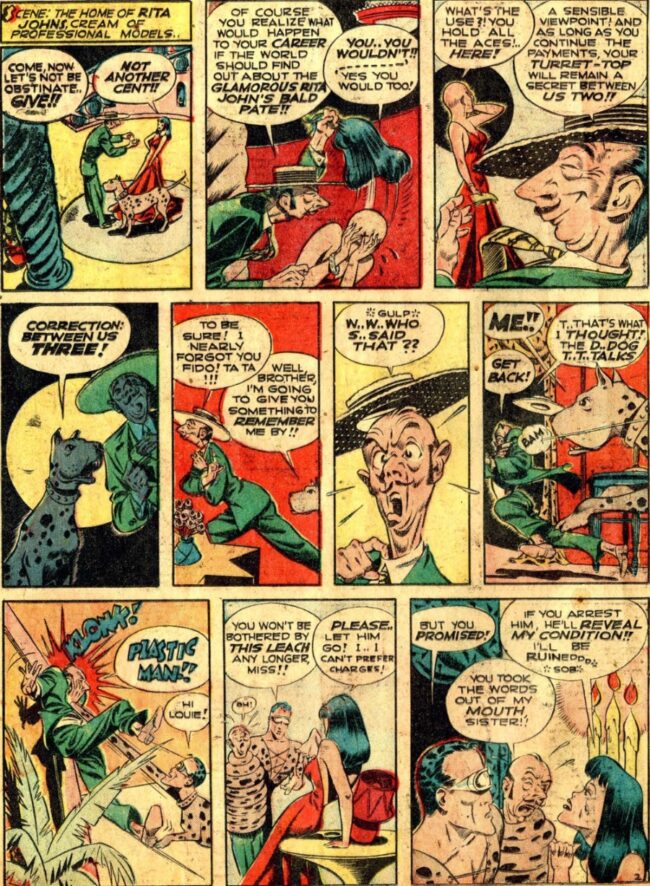Plastic Man wasn't a character made and liked for his rich inner world and iconic symbolism – he was made as a vehicle for the skills of a particular artist, the character’s creator Jack Cole. Cole has long been admired among his golden-age comic-book artist brethren; said to own artistic skills on par with the more renowned newspaper artist of the period (Cole actually left the comic-book industry for a lucrative illustration job in Playboy, which showed his more illustrative qualities). Indeed, one of the alleged reasons Cole left monthly comic-books was the pace they required; for Cole, sacrificing the quality of his work wasn't an acceptable compromise.
Cole was the subject of a fawning article by Art Spiegelman in the New Yorker (April 19, 1999). These were the halcyon days - before Chris Ware was engineered in a lab to bring the word of comics to New Yorker readers like the Silver Surfer heralding Galactus; the idea of doing a fawning feature about comics, and a jokey cape comics at that, might have been shocking. Spiegelman’s usual self-deprecating shtick is stretched to its limit (“I’m embarrassed to confess to being in love with a superhero comic, but Jack Cole’s “Plastic Man” belongs high on any adult’s How to Avoid Prozac list”), but his appreciation of the work is genuine. He (and designer Chip Kidd) later expanded it into the book Jack Cole and Plastic Man: Forms Stretched to Their Limits. As Spiegelman says, without really saying it, the success of Plastic Man was heavily dependent on Cole’s style. He wasn’t a Batman or a Superman that could flower under different artistic control. Plas was Jack Cole’s world, and without him the series waned.

Spiegelman’s article was correct in its appreciation of the formalistic brilliance of Jack Cole – here was an artist who took full advantage of his creation’s malleable shtick, transforming both character and comics in radical ways; wallowing in his playful style in a manner, with every string its own tiny celebration of creativity. His stablemates in Police Comics (Firebrand, Agent 711, the Mouthpiece) were all of a type, and equally dull in their stern-faced no-nonsense slugfests (though some occasionally reached brilliance in their straight brutalism). You could switch the titles and masks around and no one would notice. Not so with Plastic Man.
In a story featured in Police Comics #15 Plastic Man takes on a scientist using a weather control machine to freeze Mexico. While most series would present this already-rote idea in the expected manner, Cole instead portrays the character of the North Wind as Greek Chorus throughout the story, looking over the folds of panels and commenting on the plot as Plastic Man stretches all over the place. The story continues its fourth-wall breaking until the machine is triggered at which he point the North Wind his unnatural need to cast cold on the warm region. It’s a completely unnecessary flash of creativity that enlivens an otherwise prototypical mad scientist typical story.

In another story in Police Comics #8, Plastic Man faces a criminal gang using a strange machine that launches gigantic guided billiard balls throughout the city. The story starts strong enough, with a title page in which the letters of Plastic Man’s name are tilted as if they’ve just been struck while a ball goes through three buildings in a row – selling to reader the scale of destruction. Below this presentation is a three panel stretch depicting the device which ends with our evil mastermind so delighted by his own capacity for evil that he blows smoke from his nostrils like a dragon. The rest of the short story is likewise filled with inventiveness, one panel demonstrating the magnetic forces of the speeding wrecking balls by depicting a cowboy sitting on a fence as his gold coins escape from his wallet and back pocket carried on the wind; his nearby friend crying as his gold-fillings likewise fly freely from his mouth.

That story is like a great Mad Magazine piece in many ways - a cloth-line to hang the gags on. Every part of the story, every page and panel, should be crammed with humour and movement, nothing wasted. Still, despite the sheer anarchy, Cole is surprisingly in control on both his art and his story; the great touch that make his Plastic Man stories age so gracefully is that Plastic Man himself isn’t a comedian, he’s a fairly serious character reacting to a crazy world by changing himself to fit every situation.
The mistake made by creators following Jack Cole, and I include Kyle Baker in this bunch, is to miss that seriousness of the character is essential part of the gag. A good straight-man can make or break a comic-routine. Instead, the minute he bounced into the DC universe Plastic Man became ‘the funny one’ often written by people who don’t really know how to write good gags and artists whose style fails to convoy the right sort of energy. Like CC Beck's Captain Marvel, Plastic Man lost something when he was taken out of his own whimsical universe, defined by extremely idiosyncratic creators, and forced into the wide open sandbox of shared superhero universe.